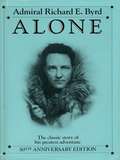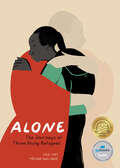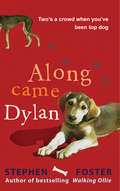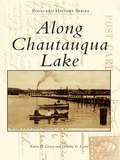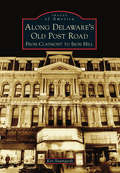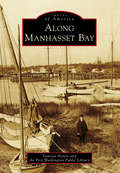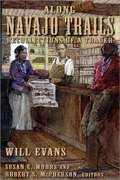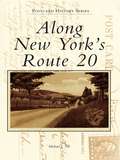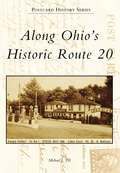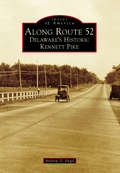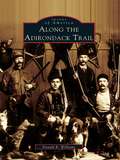- Table View
- List View
Alone: The Classic Polar Adventure
by Richard E. ByrdWhen Admiral Richard E. Byrd set out on his second Antarctic expedition in 1934, he was already an international hero for having piloted the first flights over the North and South Poles. His plan for this latest adventure was to spend six months alone near the bottom of the world, gathering weather data and indulging his desire "to taste peace and quiet long enough to know how good they really are." But early on things went terribly wrong. Isolated in the pervasive polar night with no hope of release until spring, Byrd began suffering inexplicable symptoms of mental and physical illness. By the time he discovered that carbon monoxide from a defective stovepipe was poisoning him, Byrd was already engaged in a monumental struggle to save his life and preserve his sanity. When Alone was first published in 1938, it became an enormous bestseller. This edition keeps alive Byrd's unforgettable narrative for new generations of readers.
Alone: The Journeys of Three Young Refugees
by Paul TomEach year, more than 400 minors arrive alone in Canada requesting refugee status. They arrive without their parents, accompanied by no adult at all. Alone relates the journey of three of them: Afshin, Alain and Patricia. Their story opens a window onto the many heartbreaks, difficult sacrifices and countless hardships that punctuate their obstacle-filled path. But Alone most especially tells of the courage and resilience that these young people demonstrated before being able to finally obtain a life where threats and danger are no longer a part of their everyday existence. Key Text Features: author's note captions chapters character drawings comic map dialogue flags further information illustrations introduction maps writing inspiration Correlates to the Common Core State Standards in English Language Arts: CCSS.ELA-LITERACY.RI.6.3 Analyze in detail how a key individual, event, or idea is introduced, illustrated, and elaborated in a text (e.g., through examples or anecdotes). CCSS.ELA-LITERACY.RI.6.7 Integrate information presented in different media or formats (e.g., visually, quantitatively) as well as in words to develop a coherent understanding of a topic or issue.
Alonement
by Francesca SpecterHow to be alone and absolutely own it, by founder of the Alonement blog and podcast, Francesca Specter.Being alone has a serious branding issue. We've only ever had negative language to talk about flying solo - but what about when time spent alone is restorative and joyful? What if it's something you crave? What if it's even just an hour you've carved out yourself in the middle of a hectic week? Enter: Alonement, Francesca Specter's empowering new word to express valuing your own company and carving out time to spend with yourself, whoever you are and whatever your relationship status. Between open-plan offices, two-for-one vouchers and co-habiting with partners and friends, most of us don't know how to be alone - yet our life-long relationship with ourselves is the most important one we'll ever have. A reformed 'extreme extrovert' who struggled to spend even an hour alone, Francesca made the resolution in January 2019 to improve her solitude skills. Having spent two months of lockdown by herself, Francesca knows better than most how to optimise the quality of time spent alone. Packed with practical tips, insights from key experts and lessons from guests of the Alonement podcast - including Alain de Botton, Florence Given, Konnie Huq and Camilla Thurlow - Francesca reveals how we can all thrive alone, whatever our circumstances, and harness the untapped power of some meaningful time with me, myself and I.(P)2021 Quercus Editions Limited
Alonement: How to be alone and absolutely own it
by Francesca SpecterHow to be alone and absolutely own it, by founder of the Alonement blog and podcast, Francesca Specter._______________'A hugely generous and thoughtful book' - ALAIN DE BOTTON'A kind, wise celebration of solo living' - DAISY BUCHANAN'Thoughtful and thought provoking, it made me genuinely excited about spending time in my own company' - FELICITY CLOAKE_______________Being alone has a serious branding issue. We've only ever had negative language to talk about flying solo - but what about when time spent alone is restorative and joyful? What if it's something you crave? What if it's even just an hour you've carved out for yourself in the middle of a hectic week? Enter: Alonement, Francesca Specter's empowering new word to express valuing your own company and dedicating quality time to yourself, whoever you are and whatever your relationship status. Between shared homes, social plans and smartphone addictions, most of us don't know how to be alone - yet our life-long relationship with ourselves is the most important one we'll ever have. A reformed 'extreme extrovert' who struggled to spend even an hour on her own, Francesca made the resolution in January 2019 to improve her solitude skills. A year later, facing months of lockdown as a household-of-one, she valued those skills more than ever - and began sharing her wisdom with others on how to cherish time alone.Packed with practical tips, insights from key experts and lessons from guests of the Alonement podcast - including Alain de Botton, Florence Given, Konnie Huq, Vick Hope and Camilla Thurlow - Francesca reveals how we can all thrive alone, whatever our circumstances, and harness the untapped power of some meaningful time with me, myself and I.
Alonement: How to be alone and absolutely own it
by Francesca SpecterHow to be alone and absolutely own it, by founder of the Alonement blog and podcast, Francesca Specter._______________'A hugely generous and thoughtful book' - ALAIN DE BOTTON'A kind, wise celebration of solo living' - DAISY BUCHANAN'Thoughtful and thought provoking, it made me genuinely excited about spending time in my own company' - FELICITY CLOAKE_______________Being alone has a serious branding issue. We've only ever had negative language to talk about flying solo - but what about when time spent alone is restorative and joyful? What if it's something you crave? What if it's even just an hour you've carved out for yourself in the middle of a hectic week? Enter: Alonement, Francesca Specter's empowering new word to express valuing your own company and dedicating quality time to yourself, whoever you are and whatever your relationship status. Between shared homes, social plans and smartphone addictions, most of us don't know how to be alone - yet our life-long relationship with ourselves is the most important one we'll ever have. A reformed 'extreme extrovert' who struggled to spend even an hour on her own, Francesca made the resolution in January 2019 to improve her solitude skills. A year later, facing months of lockdown as a household-of-one, she valued those skills more than ever - and began sharing her wisdom with others on how to cherish time alone.Packed with practical tips, insights from key experts and lessons from guests of the Alonement podcast - including Alain de Botton, Florence Given, Konnie Huq, Vick Hope and Camilla Thurlow - Francesca reveals how we can all thrive alone, whatever our circumstances, and harness the untapped power of some meaningful time with me, myself and I.
Along Alaska Trails: An Old Sourdough
by Lois McGarveyAlong Alaska Trails, first published in 1960, is the autobiographical account of Lois McGarvey (“An Old Sourdough”), who first traveled to Alaska in 1911. McGarvey, a young widow and mother at the time, would spend the rest of her life there, meeting success and failure along the way, but always maintaining a positive attitude, despite the many hardships she encountered along the way. From the Introduction: McGarvey “succeeded greatly in befriending people and enjoying life. Through her shrewdness and industry, she accumulated money in her later years. She cooked, mined, married, raised a family, sold furs, bought and sold real estate, kept a large boardinghouse for many different sorts of people—but no strangers—and one old blind man who was penniless but well fed and clothed because of her kindness. She came back from death's door five years ago, though she now has to use a wheelchair. Lois McGarvey knows tragedy, yet writes comedy for you.” Illustrated with 13 pages of photographs
Along Came Dylan: Two's A Crowd When You've Been Top Dog
by Stephen FosterOllie was just about cured of his basketcase habits; the neurotic lurcher at last appeared to have his paws planted firmly on the ground (well, almost). But did Stephen Foster take a well-earned rest? Not. He decided one thing was missing from Ollie's life, someone who could really understand him, a friend with whom he could have dog-to-dog chats. ? If you must get another dog get a girl, the experts told Foster. So he got a boy, a pure-bred Saluki lunatic called Dylan. As soon as the new puppy peered through the door, Ollie threw his master a look of contemptuous disbelief that said, ? I refuse to have anything whatsoever to do with this. You're on your own, pal. The riotously funny Along came Dylan takes up where Foster's bestselling Walking Ollie left off, but instead of one canine conundrum, he's got two: Dylan, the outlaw, proves to be virtually untrainable; Ollie, feeling threatened, becomes increasingly antisocial, and Foster is caught in the middle wondering why man's best friends can't just be friends.
Along Came Dylan: Two's A Crowd When You've Been Top Dog
by Stephen FosterOllie was just about cured of his basketcase habits; the neurotic lurcher at last appeared to have his paws planted firmly on the ground (well, almost). But did Stephen Foster take a well-earned rest? Not. He decided one thing was missing from Ollie's life, someone who could really understand him, a friend with whom he could have dog-to-dog chats. ? If you must get another dog get a girl, the experts told Foster. So he got a boy, a pure-bred Saluki lunatic called Dylan. As soon as the new puppy peered through the door, Ollie threw his master a look of contemptuous disbelief that said, ? I refuse to have anything whatsoever to do with this. You're on your own, pal. The riotously funny Along came Dylan takes up where Foster's bestselling Walking Ollie left off, but instead of one canine conundrum, he's got two: Dylan, the outlaw, proves to be virtually untrainable; Ollie, feeling threatened, becomes increasingly antisocial, and Foster is caught in the middle wondering why man's best friends can't just be friends.
Along Came Galileo
by Jeanne BendickThis look into the life of a courageous man of faith and science has resulted in a wonderful work sure to delight many readers. It was Galileo's questioning mind and insatiable curiousity which drove him to monumental breakthroughs in astronomy, physics, mechanics and the natural world. His many discoveries and inventions challenged and eventually changed 'the acceptabled way of thinking' in these fields of thought. Sadly, Galileo was far ahead of his times and he suffered much injustice for daring to speak those things he knew to be true.
Along Came Google: A History of Library Digitization
by Roger C. Schonfeld Deanna MarcumAn incisive history of the controversial Google Books project and the ongoing quest for a universal digital libraryLibraries have long talked about providing comprehensive access to information for everyone. But when Google announced in 2004 that it planned to digitize books to make the world's knowledge accessible to all, questions were raised about the roles and responsibilities of libraries, the rights of authors and publishers, and whether a powerful corporation should be the conveyor of such a fundamental public good. Along Came Google traces the history of Google's book digitization project and its implications for us today.Deanna Marcum and Roger Schonfeld draw on in-depth interviews with those who both embraced and resisted Google's plans, from librarians and technologists to university leaders, tech executives, and the heads of leading publishing houses. They look at earlier digital initiatives to provide open access to knowledge, and describe how Google founders Sergey Brin and Larry Page made the case for a universal digital library and drew on their company's considerable financial resources to make it a reality. Marcum and Schonfeld examine how librarians and scholars organized a legal response to Google, and reveal the missed opportunities when a settlement with the tech giant failed.Along Came Google sheds light on the transformational effects of the Google Books project on scholarship and discusses how we can continue to think imaginatively and collaboratively about expanding the digital availability of knowledge.
Along Chautauqua Lake (Postcard History Series)
by Dorothy E. Levin Karen E. LivseyShortly after settlement began along Chautauqua Lake, steamboats furnished transportation and the first hotel catered to visiting hunters and fishermen. Families escaping the summers in the city soon followed to enjoy the cool, healthy air. Chautauqua Institution and Point Chautauqua both began as religious assembly grounds. Celoron Park, often called the "Coney Island of the West," and later Midway Park provided entertainment for families and attracted thousands of visitors who traveled by trolley and steamboat in the summer. Local residents and visitors alike enjoyed the parks, picnic groves, and assorted resorts along the lake. A century later, fish are still caught, boats still ply the waters, and families continue to enjoy everything Chautauqua Lake has to offer.
Along Delaware's Old Post Road: From Claymont to Iron Hill
by Ken BaumgardtAlong Delaware's Old Post Road: From Claymont to Iron Hill snakes through the Colonial towns of Claymont, Wilmington, Newport, Stanton, Christiana, and the Pencader Hundred portion of northern Delaware. This 13-mile route has different names, from Philadelphia Pike to Maryland Avenue to Old Baltimore Pike, but it is along this road that the State of Delaware has its earliest roots. The photographs of the people and places are mostly misty memories as the route grew from a narrow dirt road to a modern four-lane thoroughfare. From Cooch's Bridge at one end, where the only battle on Delaware soil was fought, to Archmere Academy at the northern end, the corridor has a largely forgotten place in history. Travelers now trace the same route once traversed by George Washington, Thomas Jefferson, and Charles Mason and Jeremiah Dixon as they rode into history.
Along Different Lines: 70 Real Life Railway Stories
by Geoff Body Bill ParkerRunning a railway is a complex business. However well-run it is there will always be surprises, often hilarious, frequently unexpected, sometimes serious. Here railway professionals recall notable incidents from across their careers on the railways, lovingly compiled by expert railwaymen and authors Geoff Body and Bill Parker. The incidents covered in this illustrated book include such bizarre ‘everyday’ events as coping with hurricanes, rogue locomotives and runaway wagons, PR successes and otherwise, the Brighton Belle, Flying Scotsman and Mallard, training course capers, a wino invasion, trackside antics, the Eurostar backdrop, the birth of a prison, and royal and other special occasions. An enjoyable look back at life on the railways.
Along Freedom Road
by David S. CecelskiDavid Cecelski chronicles one of the most sustained and successful protests of the civil rights movement--the 1968-69 school boycott in Hyde County, North Carolina. For an entire year, the county's black citizens refused to send their children to school in protest of a desegregation plan that required closing two historically black schools in their remote coastal community. Parents and students held nonviolent protests daily for five months, marched twice on the state capitol in Raleigh, and drove the Ku Klux Klan out of the county in a massive gunfight. The threatened closing of Hyde County's black schools collided with a rich and vibrant educational heritage that had helped to sustain the black community since Reconstruction. As other southern school boards routinely closed black schools and displaced their educational leaders, Hyde County blacks began to fear that school desegregation was undermining--rather than enhancing--this legacy. This book, then, is the story of one county's extraordinary struggle for civil rights, but at the same time it explores the fight for civil rights in all of eastern North Carolina and the dismantling of black education throughout the South.
Along Highways and Hedges
by Hedy DurksenFor many years the Wiebes have shared their mission experience and outreach vision at conferences, in church circles and in private conversations. Both Joe and Marie have a way of verbalizing their personal faith which has placed them in great demand as speakers. Their authentic and genuine stories and reports have inspired and motivated many an audience. Now these experiences are available in this book. You will be delighted and encouraged as the life story of Joe and Marie unfolds on these pages. Unfortunately only a superficial treatment is possible within the limitations of a book this size. The writing of this book was initiated by the Home Missions Committee of the Manitoba Mennonite Brethren Conference in recognition of the many years of faithful and devoted ministry of the Wiebes. The prayer of the Committee is that this book will stimulate readers to a deeper faith in God and that the Wiebe's exemplary life of service may inspire others to do likewise. The Committee is particularly grateful to the Wiebes for agreeing to have this book written. We appreciate the many hours that have gone into preparation, planning and research by Joe and Marie. It is the conviction of the Committee that a lifetime of such notable service unto God deserves to be highlighted. The resourcefulness of Joe and Marie and the richness of their experiences along with their fulfilled and fruitful ministry of many years make them a suitable choice for a missionary biography. You will find yourself loving the Wiebes in a unique way as you read the book. The author, Mrs. Hedy Durksen must be complimented for capturing and portraying so well the true character and spirit of Joe and Marie. Hedy has a style of writing that is vivid and picturesque. She lets the reader enter into this true life story in a way that makes one actually feel a part of the joys and sorrows as experienced by the Wiebe family. The author demonstrates a particular skill in presenting to the reader a family so richly blessed and yet so down to earth. In the words of Joe and Marie, the purpose of this book is essentially the same as the purpose of their life, to honor the name of Jesus. It is further to be a record of God's faithfulness in giving daily guidance, performing miracles, supplying needs, and giving strength in times of hardship, tests and trials. Joe and Marie would like this book to be a challenge and encouragement to fellow workers and for those who want to go into the ministry, to arouse a vision and desire within Christians to do more personal witnessing and evangelism, to encourage uncommitted readers to put their faith in Jesus Christ as their Savior and Lord. We also recognize and appreciate the helpfulness of all those who have been involved in supplying background information to the author and for those who have assisted in the preparation of the manuscript. Particular mention must be made of the Committee members who must be credited for their ongoing concern to remember and preserve the experiences of our present day faith heroes. It has been largely through their efforts that this book has been published. In conclusion I want to express my personal delight in seeing this book printed. It has been my privilege to work together with the Joe Wiebes for many years. Their life and faith has been an inspiration to us as a family on many occasions. I consider it a real honor to have been asked to write the foreword for a book about such special people. We thank God for them and wish them God's best. James Nikkei, Missions Field Director, August, 1977
Along Iowa's Historic Highway 20
by Michael J. TillUS Highway 20 was designated a federal highway in 1926. For the first half of the 20th century, it was the most important east-west road across northern Iowa, extending from the Mississippi to the Missouri River. The road connected 13 counties, four major metropolitan areas, and many smaller communities along its route. Fortunately, the historic two-lane road remains almost completely intact and can be driven much as travelers did in years gone by. Along Iowa's Historic Highway 20 celebrates such a trip, illustrated by more than 200 antique postcards that show the personality of the road: town and city scenes, rural vistas, rivers, bridges, and historic sites. Not to be forgotten are the tourist courts, hotels, diners, and gas stations that made travel possible.
Along Lake Michigan: Shipwreck Stories of Life and Loss
by Michael SchumacherNotable shipwrecks of Lake Michigan throughout a century of enterprise, industry, heroism, and disaster on the Great Lakes The Great Lakes are graveyards of a vast number of shipwrecks (30,000 by some estimates), and Lake Michigan has more than the other four lakes combined. The stories of those wrecks tell the history of that mighty lake in its endless, mercurial challenge to human endeavor. Surveying the wreckage throughout the decades, from the fiery end of the twin propeller–driven Phoenix in 1847 to the failure of the Anna Minch to outrun the infamous 1940 Armistice Day storm, Michael Schumacher charts the course of shipping disasters great and small on Lake Michigan. He illuminates the details of maritime weather and shipcraft, the lives devoted to and lost on the water, and the mistakes and monumental failures that led to these ships&’ watery ends. Schumacher&’s deft storytelling, drawing from deep research and comprehensive knowledge, brings forth the vivid details of the last minutes of these doomed ships, along with the circumstances surrounding their voyages. Here are tragic tales like that of the Eastland, the deadliest shipwreck in Great Lakes history, lost while docked in the Chicago River; the Rouse Simmons, a wooden schooner loaded with Christmas trees; the train ferry Milwaukee and the Wisconsin, a package freighter, gone within one week of each other in October 1929; and the passenger vessel the Lady Elgin, a devastating loss met with incredible heroism. Liberally illustrated with historical photographs, the stories of these shipwrecks, spanning a full century of commercial traffic on Lake Michigan, document the myriad forms of bravery and misfortune that mark our encounters with the Great Lakes.
Along Manhasset Bay (Images of America)
by Port Washington Public Library Vanessa NastroThe waters of Manhasset Bay have long been an incubator for innovation and prosperity. While early baymen sought their livelihood through clam digging and fishing, a new industry by way of sand mining forever changed the bucolic hilltops that overlooked the bay. While the sand mining industry brought prosperity and notoriety, the industry's use of heavy machinery and hydraulic pumps leveled the peninsula, once known for its lush grazing pastures. During the early 1900s, areas such as Port Washington, Manhasset, and Great Neck flourished into commuter, suburban towns. Shifting from a farming to a suburban community, homes began to develop along Manhasset Bay. Urbanization brought new housing and businesses such as hotels and lavish restaurants. As an epicenter for aviation, the bay launched historic flights through a then-fledgling Pan American Airway Corporation on Manhasset Isle. Elite yacht clubs and grand estates dotted the shoreline, all catering to a growing population looking to the bay for its leisure and livelihood. The once-tranquil waters are now a hub for city vacationers, bustling commuters, and entrepreneurs.
Along Navajo Trails: Recollections of a Trader
by Will EvansA piece of Navajo history otherwise forgotten: the first-hand observations of a Mormon trader on the culture and art of his Navajo contemporariesThe overwhelming interest of Will Evans, proprietor of the Shiprock Trading Company, in Navajo culture spanned a half century. He shared his enthusiasm through frequent publication of portraits, vignettes, and essays; he also compiled much of his writing into a book manuscript. His subjects were his customers, friends, and neighbors, their stories of historic events such as the Long Walk, and their life as he understood it. Evans&’s writings were colored by his uncommon friendship and familiarity with Navajo people but also by who he was: a trader, folk artist, and Mormon. Inspired by sand paintings, Evans appropriated their sacred images for his own paintings of murals and everyday objects. In his writing, he preserved unique records of Navajo history and of individuals about whom little biographical information otherwise remains. Much of that was based on what he heard from his Navajo acquaintances, but it also drew on his direct observations and particular beliefs about the people, their culture, and their history. Evans&’s granddaughter Susan E. Woods collaborated with historian Robert S. McPherson, author of numerous books on Navajo and Four Corners history, to prepare and publish Will Evans&’s manuscript, which is illustrated with a remarkable and rare selection of photos from the collections of Evans and his colleagues.
Along Navajo Trails: Recollections of a Trader, 1898-1948
by Will EvansWill Evans's writings should find a special niche in the small but significant body of literature from and about traders to the Navajos. Evans was the proprietor of the Shiprock Trading Company. Probably more than most of his fellow traders, he had a strong interest in Navajo culture. The effort he made to record and share what he learned certainly was unusual. He published in the Farmington and New Mexico newspapers and other periodicals, compiling many of his pieces into a book manuscript. His subjects were Navajos he knew and traded with, their stories of historic events such as the Long Walk, and descriptions of their culture as he, an outsider without academic training, understood it. Evans's writings were colored by his fondness for, uncommon access to, and friendships with Navajos, and by who he was: a trader, folk artist, and Mormon. He accurately portrayed the operations of a trading post and knew both the material and artistic value of Navajo crafts. His art was mainly inspired by Navajo sandpainting. He appropriated and, no doubt, sometimes misappropriated that sacred art to paint surfaces and objects of all kinds. As a Mormon, he had particular views of who the Navajos were and what they believed and was representative of a large class of often-overlooked traders. Much of the Navajo trade in the Four Corners region and farther west was operated by Mormons. They had a significant historical role as intermediaries, or brokers, between Native and European American peoples in this part of the West. Well connected at the center of that world, Evans was a good spokesperson.
Along New York's Route 20 (Postcard History Series)
by Michael J. TillFew roads can match Route 20's beauty, history, or contribution to New York's vitality. In 1926, Route 20 became a federal highway and evolved into New York's foremost east-west road. But unlike most early highways, it has survived almost completely intact. The story of Route 20 is told through more than 200 vintage postcards showing scenes from the Shaker communities in Columbia County to the Lake Erie Shore. The postcards show the personality of the road: main streets, the Finger Lakes, and scenic vistas. Not to be forgotten are the tourist courts, hotels, diners, and gas stations that made travel possible.
Along Ohio's Historic Route 20 (Postcard History Series)
by Michael J. TillRoute 20 was named a federal highway in 1926, and for the first half of the 20th century it was the most important east-west road across northern Ohio. Extending from the Pennsylvania border east of Conneaut to its western terminus with Indiana, it made Ohio the connecting link between Northeastern and Midwestern states. Fortunately, Route 20 has remained virtually intact and can be traveled much as people did in years past. Postcard History Series: Along Ohio's Historic Route 20 celebrates such a trip, illustrated by more than 200 vintage postcards depicting views along the way. Town and city scenes, rural vistas, and historic sites that drew early motorists to the highway are featured. Not to be forgotten are the tourist courts, hotels, diners, and gas stations that made automobile journeys possible.
Along Route 52: Delaware's Historic Kennett Pike (Images of America)
by Andrew D. EngelCreated through an act of the Delaware Legislature in 1811, the Wilmington and Kennett Turnpike would become one of the most important roads in New Castle County. Linking the city of Wilmington, Delaware, to Kennett Square, Pennsylvania, it would become crucial in the transportation of goods from a growing industrial Wilmington to Philadelphia and the eastern counties of Pennsylvania. Kennett Pike, as it would come to be known, operated as a toll road until it was purchased in 1919 by industrialist Pierre S. du Pont (1870-1954). Du Pont would work over the next year and a half to widen and modernize the highway and eliminate its tolls. When work was completed, he sold the road back to the state for just $1. Kennett Pike has continued to grow through the 20th century, with dozens of private estates gracing its borders. Villages such as Greenville and Centreville have been characterized by their country charm and local businesses, including Shields Lumber & Coal and Buckley's Tavern.
Along Route 6 in Massachusetts (Postcard History Series)
by James A. GayRoute 6 in Massachusetts runs from Provincetown to Seekonk and passes through some of the most beautiful scenery in the state. What had once been a mere footpath for Native Americans, then widened for the use of stagecoaches, Route 6 would be officially designated the “King’s Highway” in 1920. The moniker was extremely unpopular with the local residents, so much so that the governor officially changed the name to the Grand Army of the Republic Highway in 1937. Depicted from the author’s personal collection of postcards from the 1920s to the 1960s, Route 6 winds its way around tiny fishing villages, sand dunes, marshes, beaches, lighthouses, campgrounds, hotels, restaurants, and historic cities. The combination of Route 6 and the automobile would make Cape Cod a world-renowned tourist destination.
Along The Adirondack Trail
by Donald R. WilliamsNative Americans called the area Couxsaxrage, "beaver hunting ground." Professor Ebenezer Emmons named it Adirondack, after one of the native tribes. Along the Adirondack Trail traces the history and lore of the Adirondacks up the scenic roadway through the heart of New York's mountain-and-lake country. Included are tales of the Mohawk Indians and their beatified princess, Tekakwitha; the site of the mansion of Sir William Johnson, one of America's most influential citizens of the 1700s; and an important battleground of the Revolution. Rare original photographs portray each of the twenty settlements on the trail from Fonda to Malone, reflecting the lives of the guides, loggers, trappers, sportsmen, camp owners, tourists, leather workers, and health seekers who opened up the unknown county.
